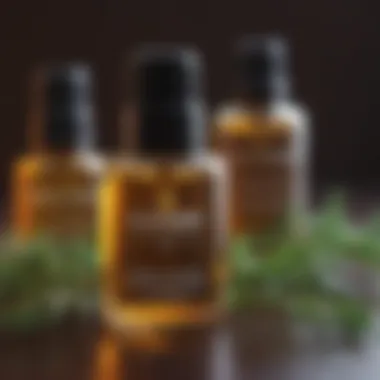Effective Home Remedies to Treat Ingrown Hairs Naturally


Trend Report
Ingrown hairs can be a common nuisance, causing discomfort and affecting the skin's appearance. This section will delve into the latest trends in home remedies for ingrown hairs, shedding light on natural and effective solutions to tackle this issue. From analyzing the most recent techniques to discussing the relevance of these remedies, it's essential to understand the evolving trends in addressing ingrown hairs.
Natural Remedies
When it comes to managing ingrown hairs, natural remedies offer safe alternatives to conventional treatments. These solutions focus on reducing inflammation, preventing infections, and soothing the skin. From tea tree oil to aloe vera, the efficacy of these remedies lies in their soothing and anti-inflammatory properties. Discover how these natural ingredients can help alleviate ingrown hairs effectively.
DIY Treatments
DIY treatments are gaining popularity for their effectiveness and cost-efficiency in addressing ingrown hairs. By using simple ingredients found at home, individuals can create exfoliating scrubs, soothing masks, and antibacterial solutions to treat and prevent ingrown hairs. These step-by-step tutorials will guide you through the process of making and applying these DIY treatments, offering a holistic approach to skincare.
Lifestyle Adjustments
Incorporating certain lifestyle adjustments can also play a significant role in preventing ingrown hairs. From choosing the right clothing materials to practicing proper exfoliation techniques, small changes in daily habits can make a big difference in reducing the occurrence of ingrown hairs. By understanding how factors such as shaving techniques and skincare routines impact ingrown hairs, individuals can proactively prevent them from occurring.
Conclusion
Understanding Ingrown Hairs


In this segment of our comprehensive guide on ingrown hairs, we delve deep into understanding the intricacies of this common skin concern. Understanding ingrown hairs is paramount for effective treatment and prevention strategies. By grasping the root causes and mechanisms behind ingrown hairs, individuals can adopt proactive measures to combat this issue head-on, leading to healthier and smoother skin. This section sheds light on the importance of recognizing ingrown hairs, both in terms of addressing existing problems and preventing future occurrences.
What Are Ingrown Hairs?
Ingrown hairs, medically known as pseudofolliculitis barbae, occur when a hair curls back or grows sideways into the skin instead of rising up from it. This anomaly often leads to inflammation, redness, and sometimes, infection in the affected area. The most common sign of ingrown hairs is the development of small, painful bumps on the skin, primarily in areas where hair removal methods like shaving or waxing are prevalent. Understanding the nature of ingrown hairs is crucial for differentiating them from other skin conditions and implementing targeted treatment approaches.
Causes of Ingrown Hairs
Multiple factors contribute to the development of ingrown hairs, including improper shaving techniques, curly or coarse hair, and dead skin cell buildup. When hair removal methods such as shaving cut the hair below the skin's surface, the regrowing hair may coil back into the skin, triggering an ingrown hair. Additionally, individuals with tightly curled hair are more prone to ingrown hairs due to the hair's natural tendency to grow back into the skin. Understanding these causative factors is vital for formulating effective home remedies and preventive strategies.
Risk Factors
Several risk factors heighten the likelihood of experiencing ingrown hairs, with certain demographics being more susceptible than others. Individuals with thick, curly hair are at an increased risk of developing ingrown hairs, as the hair's texture and growth pattern make it more prone to bending back into the skin. Moreover, frequent shaving with dull razors or using improper shaving techniques can exacerbate the risk of ingrown hairs by not allowing hairs to grow properly. Recognizing these risk factors is essential for tailoring targeted interventions to reduce the incidence of ingrown hairs and improve overall skin health.
Preventive Measures
In the realm of tackling ingrown hairs, preventive measures hold a crucial role in this narrative. Their significance lies in their ability to not only address existing ingrown hairs but also to proactively thwart future occurrences. By incorporating preventive measures into one's skincare routine, individuals can maintain healthy skin and reduce the likelihood of ingrown hairs. This section delves into various preventive techniques, shedding light on their efficacy and practicality. Emphasizing the importance of preemptive actions can significantly impact the overall well-being of the skin, making it a pivotal aspect of this discussion.
Exfoliation Techniques
Chemical Exfoliants


When discussing exfoliation techniques for combating ingrown hairs, chemical exfoliants stand out for their unique properties and benefits. Chemical exfoliants work by gently dissolving dead skin cells and unclogging pores, preventing hair follicles from becoming trapped and causing ingrown hairs. Their efficacy lies in their ability to reach deep into the skin, promoting cell turnover and rejuvenation. While chemical exfoliants may offer exceptional results, it is essential to use them cautiously to avoid skin sensitivities. Understanding the nuances of chemical exfoliants is pivotal in harnessing their full potential for alleviating ingrown hairs effectively.
Physical Exfoliation
On the other hand, physical exfoliation plays a key role in the skincare regimen to combat ingrown hairs. Unlike chemical exfoliants, physical exfoliation involves using granular substances or tools to manually remove dead skin cells and impurities from the skin's surface. This process aids in smoothing the skin, preventing blockages that lead to ingrown hairs. While physical exfoliation offers immediate results, it is important to strike a balance to prevent skin irritation or damage. By understanding the benefits and limitations of physical exfoliation, individuals can tailor their routine for optimal skin health and ingrown hair prevention.
Proper Hair Removal Methods
Avoiding Close Shaving
The decision to avoid close shaving plays a pivotal role in reducing the likelihood of ingrown hairs. Close shaving increases the risk of hair curling back into the skin, leading to inflammation and ingrown hairs. Opting for methods that leave a bit of stubble can help prevent hairs from growing beneath the skin's surface. By embracing techniques that prioritize skin health over a perfectly smooth shave, individuals can significantly diminish the occurrence of ingrown hairs. Understanding the repercussions of close shaving underscores the importance of choosing alternative hair removal methods that prioritize skin wellness.
Using Sharp Razors
In contrast, using sharp razors emerges as a critical factor in preventing ingrown hairs. Dull blades can tug and pull at the hair, causing it to break unevenly and potentially grow back into the skin. Sharp razors ensure clean and precise cuts, reducing the likelihood of irritation and ingrown hairs. Incorporating the use of sharp razors into the hair removal routine can yield smoother results and contribute to overall skin health. Grasping the significance of using sharp razors emphasizes the importance of investing in quality tools for a seamless hair removal experience.
Moisturizing the Skin
Moisturizing the skin serves as a fundamental step in combating ingrown hairs and maintaining skin health. Proper hydration helps in keeping the skin soft and supple, reducing the risk of dryness and irritation that can exacerbate ingrown hairs. Moisturizers create a protective barrier on the skin's surface, preventing external factors from penetrating and causing inflammation. By choosing moisturizers tailored to one's skin type, individuals can nurture their skin and alleviate conditions conducive to ingrown hairs. Understanding the role of moisturization underscores its significance in promoting skin resilience and combating ingrown hairs effectively.
Home Remedies for Ingrown Hairs


Tea Tree Oil Treatment
Tea tree oil is a popular remedy known for its antiseptic and anti-inflammatory properties, making it ideal for treating ingrown hairs. When applied to the affected area, tea tree oil helps reduce redness, swelling, and itchiness associated with ingrown hairs. Its natural antibacterial qualities also aid in preventing infection, promoting faster healing. To use tea tree oil for ingrown hairs, dilute a few drops with a carrier oil like coconut oil and apply it to the affected skin. Regular application can help soothe irritation and promote the ingrown hair to surface, facilitating easier removal.
Coconut Oil Application
Coconut oil is a versatile remedy that can help alleviate ingrown hairs due to its moisturizing and anti-inflammatory properties. By hydrating the skin and reducing inflammation, coconut oil can soften the skin, making it easier to release trapped hairs. Additionally, its antibacterial nature aids in preventing infection, promoting healing. To use coconut oil for ingrown hairs, gently massage a small amount onto the affected area. The oil's nourishing effects can help soothe discomfort and encourage the hair to break through the skin's surface.
Aloe Vera Gel Soothing
Aloe vera gel is renowned for its soothing properties, making it a valuable remedy for calming irritated skin caused by ingrown hairs. Its cooling sensation helps relieve itching and redness, providing instant relief. Aloe vera also boasts anti-inflammatory benefits, which can help reduce swelling and promote healing. Applying a generous amount of pure aloe vera gel to the affected area can help ease discomfort and accelerate the healing process. Regular use of aloe vera gel can also hydrate the skin, preventing dryness that may exacerbate ingrown hairs.
Honey and Oatmeal Scrub
The combination of honey and oatmeal creates a gentle exfoliating scrub that can help release trapped ingrown hairs while nurturing the skin. Honey's antibacterial properties cleanse the skin, reducing the risk of infection, while oatmeal soothes irritation and inflammation. By gently exfoliating the affected area with this natural scrub, dead skin cells are removed, allowing ingrown hairs to resurface. To create the scrub, mix honey and oatmeal to form a paste, then massage it onto damp skin in circular motions. This remedy not only aids in ingrown hair removal but also leaves the skin soft, smooth, and nourished.
Further Treatment Options
When it comes to dealing with persistent ingrown hairs, exploring further treatment options becomes essential. While home remedies can play a significant role in managing ingrown hairs, there are instances where seeking professional assistance is necessary. These options offer more specialized care and can address severe cases effectively.
Seeking Medical Advice
For individuals struggling with chronic ingrown hairs or experiencing complications such as infection or scarring, consulting a medical professional is crucial. Dermatologists or general practitioners can provide tailored advice and treatment plans to alleviate discomfort and prevent recurrences. Medical intervention may include prescription medications, in-office procedures like corticosteroid injections, or recommendations on adjusting skincare routines. Such guidance ensures that the underlying causes are addressed comprehensively, promoting long-term skin health.
Professional Hair Removal Techniques
In some cases, individuals may opt for professional hair removal techniques to manage ingrown hairs effectively. Salons and dermatology clinics offer services such as laser hair removal, which can target hair follicles to prevent ingrown hairs from developing. Additionally, professional aestheticians can perform expert waxing or sugaring procedures, minimizing the risk of hair regrowth beneath the skin's surface. These techniques provide a long-lasting solution to ingrown hairs, enhancing skin smoothness and reducing the likelihood of future issues.



